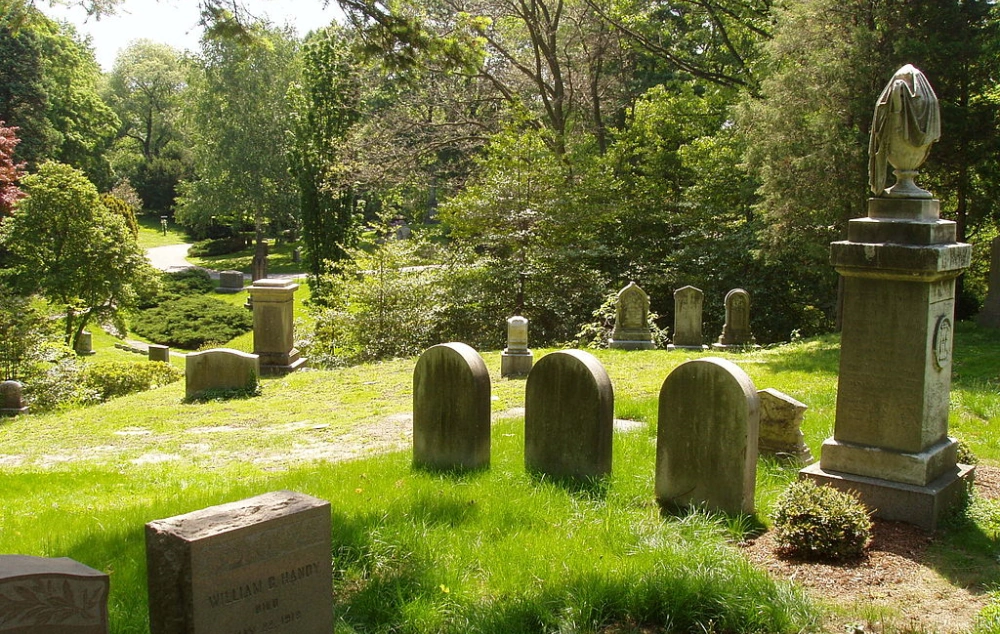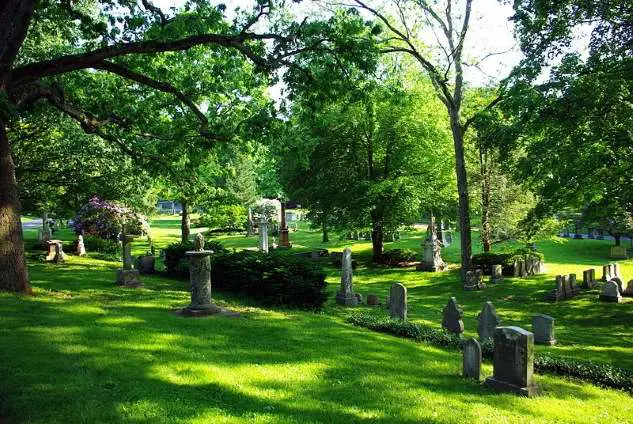In 1846, 16-year-old Emily Dickinson made a rare foray outside of her Amherst, Mass., home to visit the biggest tourist attraction on the East Coast: Mount Auburn Cemetery.
Two years later, an estimated 60,000 people visited the famous pleasure (and burial) ground — a staggering figure for the day. During the 19th century, Mount Auburn Cemetery ranked with Niagara Falls and Mount Vernon as a popular travel destination. And that was even before many of its famous dead were buried in it.
Mount Auburn Cemetery later inspired one of the most famous parks in the world.
19th Century Tourist Attraction
Mount Auburn Cemetery was originally known (appropriately enough) as Stone’s Farm, 170 rolling acres between Watertown and Cambridge, Mass.
Built in 1831, it was designed by Henry Alexander Scammell Dearborn, son of Secretary of War Henry Dearborn and named for Dearborn’s friend Alexander Scammell. He had help from Jacob Bigelow, a physician who thought it unhealthy to bury people under churches. Alexander Wadsworth, cousin of the poet Henry Wadsworth Longfellow, also helped design it. Later he would be buried there.
Dearborn, a lawyer and horticulturist, designed Mount Auburn as an artful wilderness. It had winding avenues and paths and a tower on top of Mount Auburn for a panoramic view of Boston. The first rural cemetery in America, it had an arboretum and an experimental garden.
Back then, public parks didn’t belong in the American landscape. Mount Auburn Cemetery quickly became a 19th century tourist attraction. Dearborn intended it that way. The cemetery and garden, he wrote, ‘will present one of the most instructive, magnificent and pleasant promenades in our country.’
Model Park
The rich came by carriage. The working classes came by streetcar. A slew of guidebooks, literature and personal travelers’ accounts then spread Mount Auburn’s fame as a pleasure ground. Today it has a mobile app.

Miscellaneous view of Mount Auburn Cemetery.
Landscape designer Andrew Jackson Downing observed the hordes of visitors at Mount Auburn. He also noticed people came to Boston solely to see the cemetery. And he sensed the pent-up demand for public places where people could relax and socialize outdoors.
”The idea took the public mind by storm,” he wrote. Downing recommended Mount Auburn as a model for more public parks. He thought a nation that called itself a republic should encourage people of all social classes to mingle in public places.
“The true policy of republics is to foster the taste of great public libraries, sculpture and picture galleries, parks and gardens,” he wrote.
Downing then died in 1852 in a steamboat accident on his 37th birthday. But he had paved the way for his partner, Calvin Vaux, and a young Frederick Law Olmsted. They designed New York’s Central Park, Hartford’s Bushnell Park and Springfield’s Elm Park.
Today, tourists still visit Mount Auburn Cemetery to walk winding paths in a picturesque landscape and to seek out the graves of the dead. The famous people buried there include people you’d expect: Nathaniel Bowditch, Robert Gould Shaw and Julia Ward Howe. Some of its inhabitants you wouldn’t expect: Bernard Malamud, Curt Gowdy and Joyce Chen.
Other notables also include Margaret Fuller, Harriet Jacobs, Winslow Homer and both Henry Cabot Lodges.
This story was updated in 2022. Miscellaneous view of Mount Auburn Cemetery By Daderot at the English-language Wikipedia, CC BY-SA 3.0, https://commons.wikimedia.org/w/index.php?curid=18516143. Featured image also By Daderot CC BY-SA 3.0, https://commons.wikimedia.org/w/index.php?curid=18003519.


8 comments
Robert Gould Shaw’s final resting place was a mass grave near Fort Wagner, South Carolina, so I’m not sure why people would “expect” to find his grave at Mt. Auburn.
[…] Brooks’ death in 1893 was a major event in Boston. He was buried in Mount Auburn Cemetery, where one observer wrote, ‘They buried him like a […]
[…] Anna Lowell Woodbury died on June 5, 1906, and is buried with her family in Mount Auburn Cemetery. […]
[…] Mount Auburn Cemetery in Greater Boston was the first cemetery designed as a park, but Mount Hope Cemetery in Bangor came […]
Did you mean to write “ public parts” or is it a typo ?
We meant parks! Thanks for pointing out the mistake. It’s been corrected.
[…] she raised money for orphans and campaigned for equal rights. She died in 1897, and was buried in Mount Auburn Cemetery in Cambridge, […]
[…] Roberts died on Sept. 6, 1881, at the age of 66. His family buried him in Mount Auburn Cemetery. Lemuel Shaw had died 20 years earlier, 12 days before the Civil War broke out. But his reasoning […]
Comments are closed.